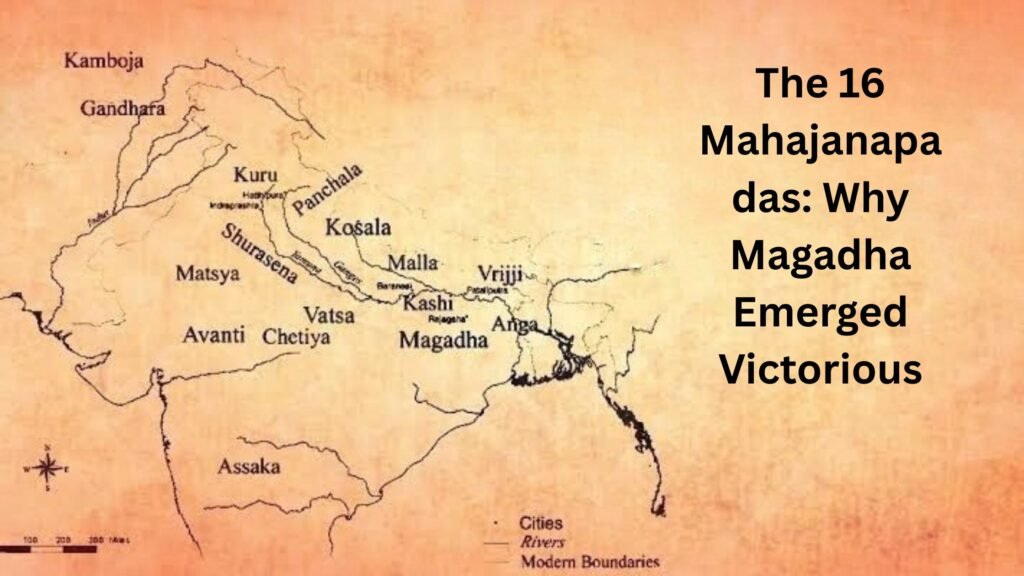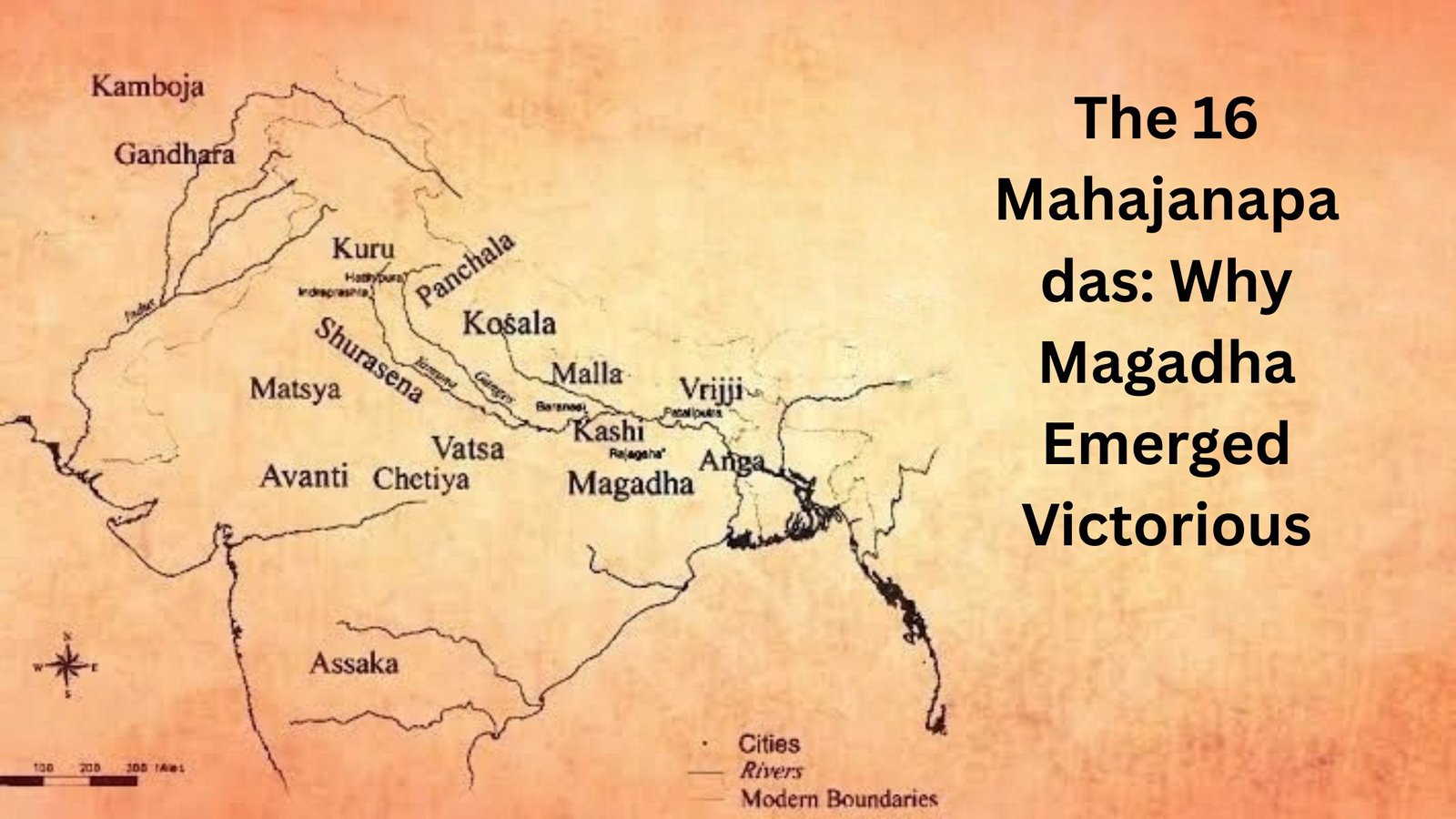The ancient Indian subcontinent was home to sixteen powerful states known as the Mahajanapadas. These kingdoms and republics played a crucial role in shaping early Indian history, engaging in intense rivalries and battles for dominance. Among them, one kingdom rose to unparalleled supremacy—Magadha. What factors contributed to its success, and how did it overshadow its competitors? This article delves into the strategic advantages that led to Magadha’s dominance over the other Mahajanapadas.

Ancient India’s Power Struggle: The Rise of Magadha
In ancient India, the 16 Mahajanapadas dominated the political landscape between the 6th and 4th centuries BCE. These territorial states engaged in constant power struggles for supremacy. Among them, one state rose to unparalleled dominance—Magadha. The question remains: What made Magadha the ultimate victor among the Mahajanapadas?
The 16 Mahajanapadas: A Brief Overview
The term Mahajanapadas refers to the sixteen great kingdoms or republics that existed during the Vedic period. These states played a crucial role in shaping early Indian civilization. The 16 Mahajanapadas were:
| No. | Mahajanapada | Region (Present-Day Location) | Vedic Period (BCE) | Political Structure |
|---|---|---|---|---|
| 1. | Anga | Bihar, parts of Bengal | 1000–500 BCE (Later Vedic) | Monarchy |
| 2. | Magadha | Bihar | 1000–500 BCE (Later Vedic) | Monarchy |
| 3. | Vajji (Vriji) | Bihar | 1000–500 BCE (Later Vedic) | Republic (Gana-Sangha) |
| 4. | Malla | Uttar Pradesh | 1000–500 BCE (Later Vedic) | Republic |
| 5. | Kashi | Uttar Pradesh (Varanasi) | 1500–500 BCE (Early & Later Vedic) | Monarchy |
| 6. | Kosala | Uttar Pradesh | 1000–500 BCE (Later Vedic) | Monarchy |
| 7. | Chedi | Madhya Pradesh | 1000–500 BCE (Later Vedic) | Monarchy |
| 8. | Vatsa | Uttar Pradesh | 1000–500 BCE (Later Vedic) | Monarchy |
| 9. | Kuru | Delhi, Haryana | 1500–500 BCE (Early & Later Vedic) | Monarchy |
| 10. | Panchala | Uttar Pradesh | 1500–500 BCE (Early & Later Vedic) | Monarchy |
| 11. | Matsya | Rajasthan | 1000–500 BCE (Later Vedic) | Monarchy |
| 12. | Surasena | Uttar Pradesh (Mathura) | 1000–500 BCE (Later Vedic) | Monarchy |
| 13. | Assaka (Ashmaka) | Maharashtra, Telangana | 1000–500 BCE (Later Vedic) | Monarchy |
| 14. | Avanti | Madhya Pradesh | 1000–500 BCE (Later Vedic) | Monarchy |
| 15. | Gandhara | Pakistan, Afghanistan | 1000–500 BCE (Later Vedic) | Monarchy |
| 16. | Kamboja | Afghanistan | 1000–500 BCE (Later Vedic) | Monarchy |
Each of these Mahajanapadas had distinct political structures, economies, and military capabilities. However, Magadha distinguished itself through strategic advantages and tactical policies.
Why Did Magadha Emerge Victorious?
While many Mahajanapadas competed for power, Magadha successfully outshined the others. Several factors contributed to its dominance:
1. Geographical Advantage
- Magadha was located in present-day Bihar, along the fertile Gangetic plains.
- The region had abundant natural resources, including iron deposits, which facilitated weapon production.
- Its strategic location near rivers like the Ganges and Son provided natural defense and trade opportunities.
2. Strong Leadership
- Bimbisara (544–492 BCE) and Ajatashatru (492–460 BCE) were visionary rulers who expanded Magadha’s territory through military conquests and strategic diplomacy.
- These kings adopted policies that strengthened administration and governance.
3. Military Strength and Warfare Innovations
- Magadha was one of the first Mahajanapadas to use war elephants, which gave them a significant battlefield advantage.
- It employed advanced siege tactics and fortification strategies to conquer rival states.
4. Political Alliances and Diplomacy
- Magadha formed alliances with powerful states and absorbed weaker ones through strategic marriages and treaties.
- It weakened its rivals by fostering internal divisions within enemy states.
5. Economic Prosperity and Trade
- The presence of iron mines allowed Magadha to develop superior weaponry and infrastructure.
- Thriving trade networks ensured a steady flow of wealth, supporting the kingdom’s expansion.
6. Administrative Reforms
- Unlike other Mahajanapadas, Magadha had a well-structured administration with an efficient taxation system.
- A centralized government helped in maintaining law and order, enabling sustained growth.

The Decline of Other Mahajanapadas
While Magadha thrived, other Mahajanapadas struggled due to various reasons:
- Kashi and Kosala faced internal conflicts and were eventually annexed by Magadha.
- Vajji (Vriji) had a republic-based governance but lacked military might to resist Magadha’s expansion.
- Avanti was a strong competitor but was ultimately overpowered.
- Gandhara and Kamboja were too distant and preoccupied with external invasions.
Magadha: The Foundation of Indian Empires
Magadha’s dominance led to the rise of the Maurya Empire, one of the greatest empires in Indian history. Chandragupta Maurya and Ashoka the Great carried forward Magadha’s legacy, expanding its influence across the Indian subcontinent.
Conclusion: Magadha’s Lasting Impact
The story of the Mahajanapadas highlights the complex dynamics of ancient Indian politics. While many states vied for power, Magadha’s strategic advantages, strong leadership, and economic prowess ensured its victory. This dominance paved the way for some of the most powerful empires in Indian history.
Magadha’s rise was not just a victory over rival Mahajanapadas; it was a defining moment in India’s historical evolution, shaping the trajectory of governance, military strategy, and economic development for centuries to come. For more insights into Indian history, visit Chandigarh UT.














